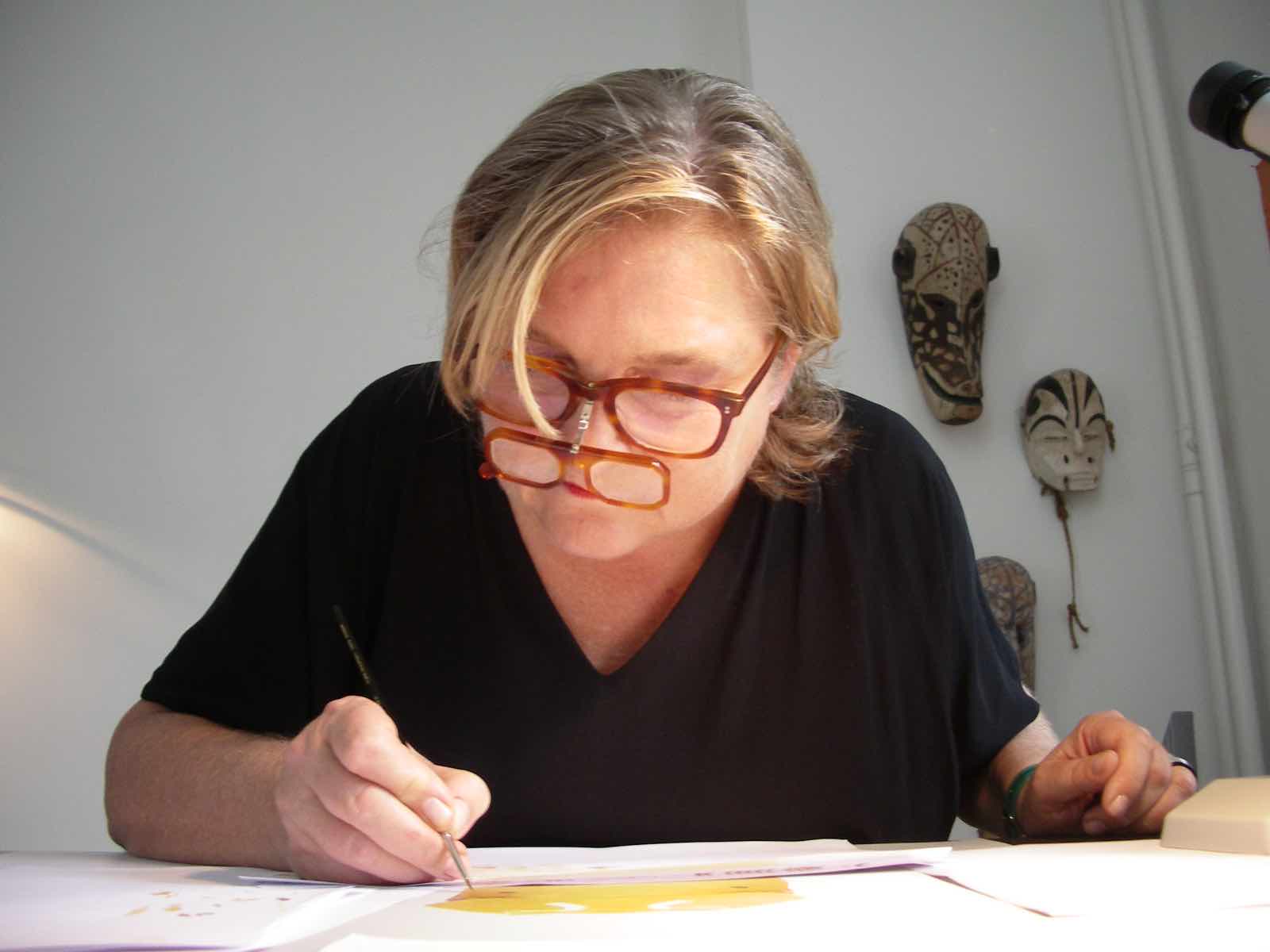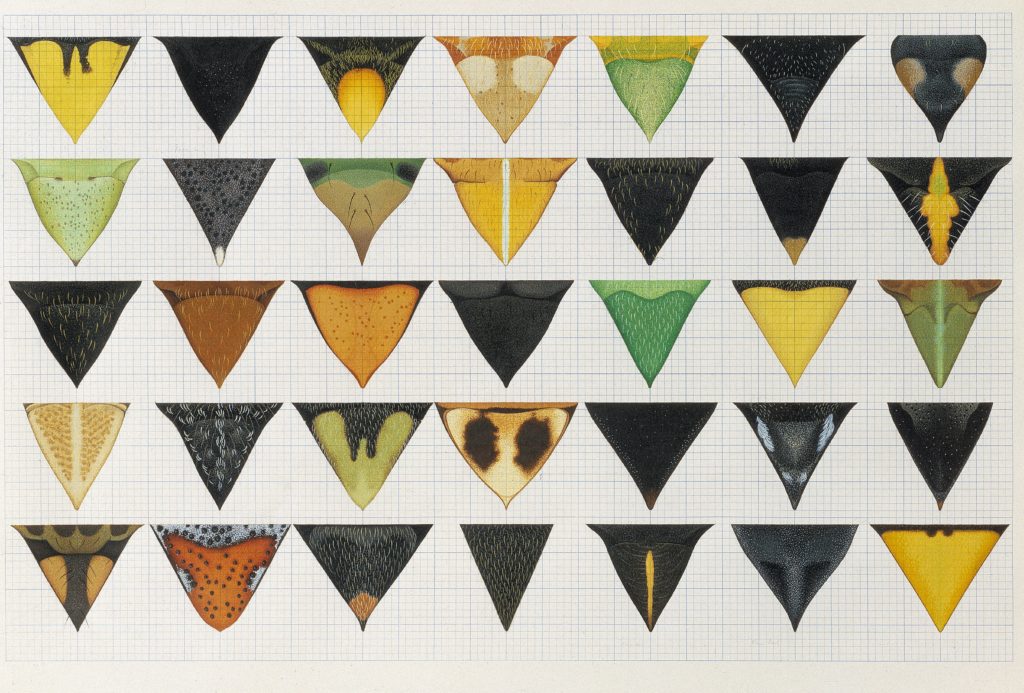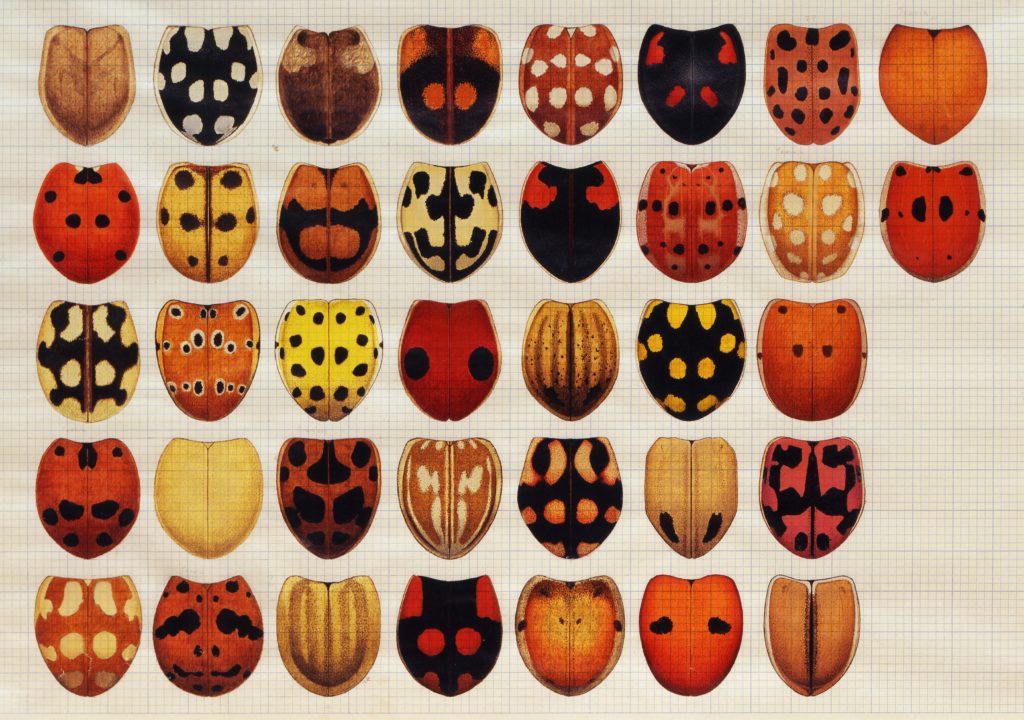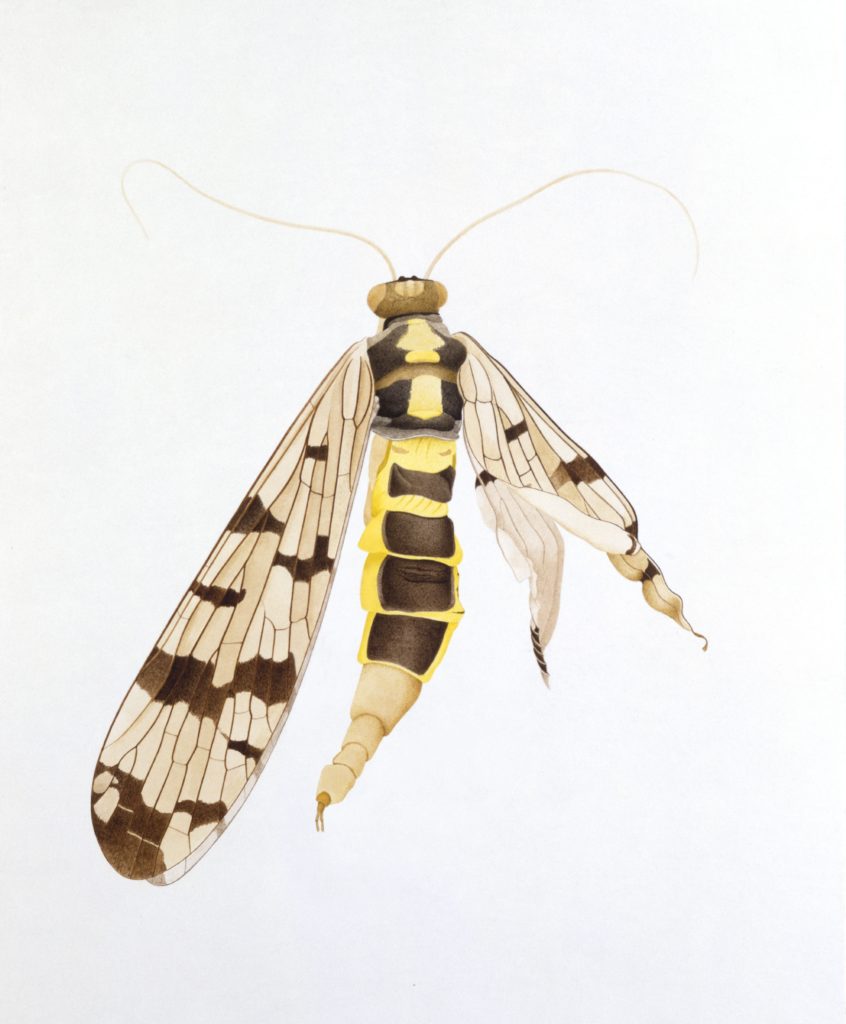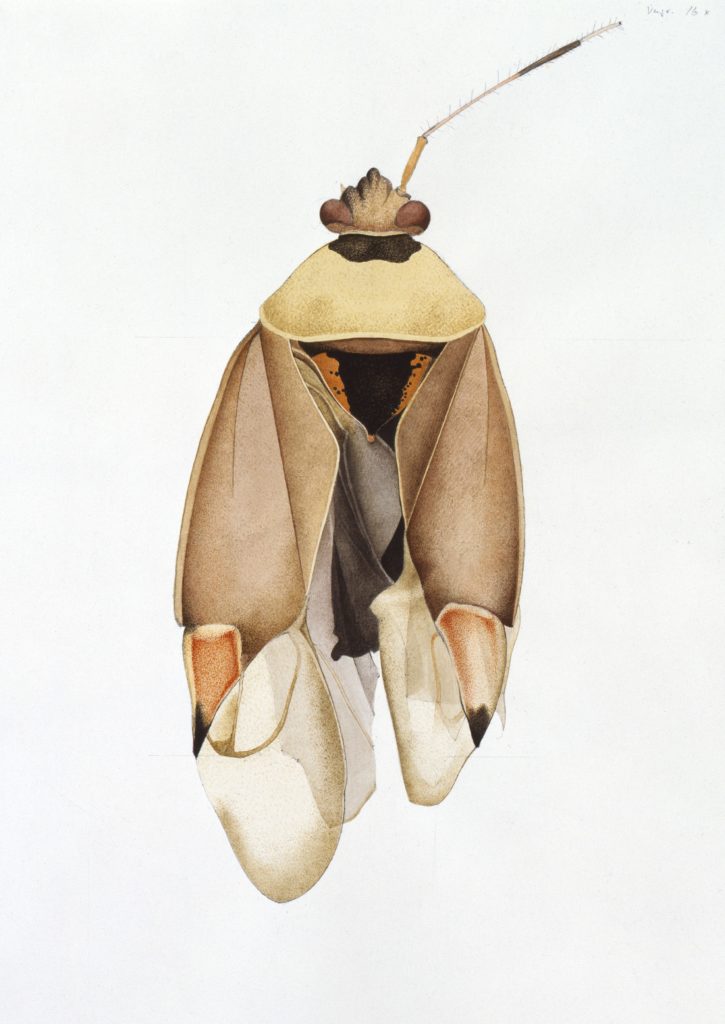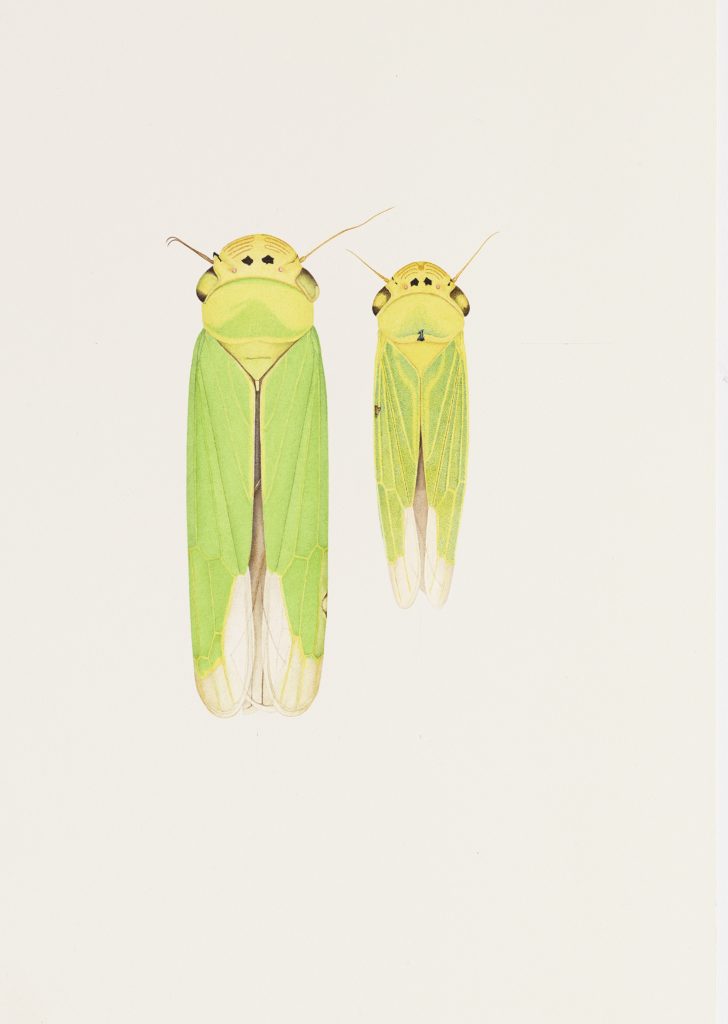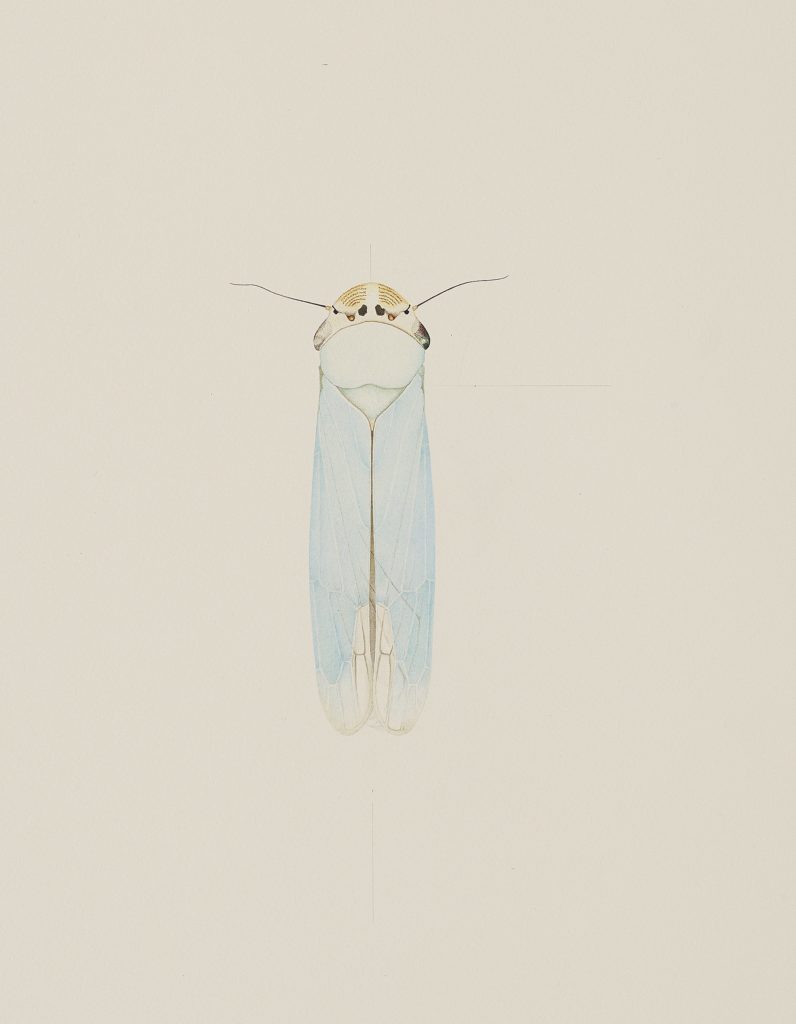Cornelia Hesse-Honegger works at the interface between art and science. An exhibitor in Bugs, Beauty and Danger, She aims to testify to the beauties of an increasingly endangered nature.
Describing herself as a ‘science artist,’ she worked for 25 years, as a scientific illustrator for the Natural History Museum at the University of Zurich. From 1969 onwards, she collected and painted true bugs, Heteroptera.
Since the catastrophe of the nuclear power accident at Chernobyl in 1986 Cornelia has collected, studied and painted morphologically disturbed insects, mostly true bugs. These, she has found in the fallout areas of Chernobyl as well as in the proximity of many other nuclear installations.
Morphologically disturbed bugs
The artist has conducted long-term research into the effects of radioactive fallout. This has convinced her that vegetation is contaminated where fallout from Chernobyl, or normal working nuclear power plants hits ground. As a consequence, insects like true bugs become to a certain degree morphologically disturbed.
She has based her field studies, mostly in Switzerland, but also in many other locations including Sellafield in the UK. Her research concludes that all nuclear installations, including normal working power plants cause deformities on true bugs, Heteroptera. Above all, they are a terrible threat to nature
Cornelia is often invited to speak at international meetings and conferences. Her collection of true bugs now amounts to over 18,000. Today she and independent scientists can prove that even the lowest amount of radiation can cause cancer, illnesses, mutations and deformations. She has published many studies highlighting this issue and her watercolours and prints are exhibited internationally in museums and galleries.
A new interview with Cornelia Hesse-Honegger
Here is the text and the film of an interview made in May 2020.
VS
So, first of all, I wondered if we could talk about the beginnings of your work as an artist and, and perhaps the beginnings of your work as a science artist? And do the two things go together?
I didn’t know I was gifted
CHH
You know, both of my parents were artists. I lived in an environment with artists visiting very famous artists like Sam Francis, Rothko, de Kooning, Riopelle, you name it, you know. Also Stockhausen. And I knew one thing: that I could never be an artist. It just, you know, I could never compare with these people. Yes, that was one thing.
The other thing – I didn’t know I was gifted. Yeah, that I had an artistic gift. Oh, then actually, my father, he found this profession for me as a scientific Illustrator. And I studied it, but I just did what he said I had to do, without thinking. Of course, I always loved to draw and to paint as a child and I went one year to the art school in Zürich.
But only maybe when I was about 60 years old, or maybe 55. But I had a lot of success with the silk scarves that I designed. And the producer made millions on it. Only then, I thought perhaps I am gifted, you know?
Also, I met a lot of artists that were very unfortunate, always trying to find a gallery, always trying to find money. And I think I knew that I didn’t want to be like that. I was glad to have a profession, to earn my money. And also I was teaching a whole life-long and working as a scientific illustrator for 25 years in the same Institute.
I think I invented something that hasn’t been made before and this is the real work of an artist
VS
And you didn’t regard that as being an artist, being a scientific illustrator?
CHH
No. I just took life as it came along. You know.
My father thought it was a very good profession for me and I had a very interesting kind of apprenticeship in the sense that I could study at the Natural History Museum in Zurich. And the professor, the Dean of the department was my teacher, sort of, and I could study everything that biologists studied. The basic courses, I studied them. And it was just natural, but I had no clue. I didn’t ask myself whether I was an artist.
And then maybe when I was 20 / 21, I started to have the first publications and then journalists would ask me, for example, ‘Do you think you are making art?’ Then I always thought this question doesn’t really interest me. And today, I think by bringing together Arts and Science, this is I what I mean by being an artist.
It’s not just you know, – you lean back and paint, you don’t have like a palette, and all the things like how you imagined an artist to work. I think the artist brings questions of today into visual form. Yes, it makes it existential sort of, that you can grab it. And I think this is in the sense I do this. I think I do this. And it is for this I think today that I’m an artist.
VS
It seems that quite early on you were asking questions about your talent. Your observation drove you to ask questions. Would you say that?
The galleries thought my work was too scientific and the scientsts thought it was too artistic
CHH
Oh, yes. So, the artistic world in Switzerland – like the galleries – they thought my work was too scientific. And the scientists thought it was too artistic.
I just don’t care. You know? I do my work. I do whatever I want to do. And then it is finished. I think that I sort of invented something that hasn’t been made before and I think this is the real work of an artist.
VS
Yes, absolutely.
CHH
I mean, I know a lot of artists, they look where the wind is coming from.
No – I think that an artist has to be critical and completely independent.
VS
So, your interest in the effect of radiation on bugs – that came from the scientific side? How did that start?
It started in 1967. I drew the first mutated flies for my professor
CHH
It started actually, in 1967.
I drew the first mutated flies for my professor. At that time, the flies were poisoned, to make mutations. And later on, in the early 80s, I painted mutated flies out of my own interest, and they were irradiated. by x rays.
And I think for me it was always that what scientists do in the laboratory is they create, like a new visual, a new form of nature by mutating them. But they don’t realise it. So, they’re just interested in the genes or the chromosomes and they don’t realise actually what they’re doing. In the bigger sense, you know, this for me is a very interesting question.
In 1985, when I was painting one of those mutated flies Musca domestica, the accident at the nuclear power plant Chernobyl happened April 26, 1986. And then I thought in a naive way, everywhere the radiation has come to the ground.
Morphological deformation
The true bugs which I had already been painting for years, when they suck out the liquids from the plants and the plant is irradiated, then they get radiation into their bodies. The next generation might show some change in their appearance, like a morphological deformation.
Then, first I went to Sweden where there was the highest radiation from Chernobyl, in Western Europe, of course. At that time, I couldn’t go to the Ukraine, you know. I went to Chernobyl in 1990. That was four years after the accident. I mean, already at that time, it was very critical to go there and very primitive you know, And that’s how it started.
VS
It’s interesting what you say about scientists not knowing what they’re doing. But you – you recognise because in a way that’s your role to see. And to bring something into being that wasn’t really there before. To consolidate what is being achieved.
I want to ask those questions which people don’t like so much to hear
CHH
I think also in society we have some blind spots, you know? We do this, and focus on – mostly what is already in our field of vision. Then we don’t see what’s happening right, left, and maybe we don’t even see what we’re doing. You know? This may be a very interesting question to get to see ‘what are we doing actually?’
I mean, we’re killing thousands and millions of people with without even wondering, you know, I mean, it’s murder in the first grade. And we don’t even question it. It’s pain and it’s illness. And yes, I want to ask those questions which of course people don’t like so much to hear.
VS
Well, they’re being asked in a variant way at the moment – there’s a much more well visible-invisible bug that is getting us now. So, once you started on this route, looking at the effects of radiation were you commissioned to carry on working like that? Or was that your own motivation? What kept you going?
Research into radiation from Chernobyl
CHH
It was absolutely my own motivation, and I also paid everything myself.
Because the scientists in Europe, they said that the radiation from Chernobyl is so low. Even the Swedish biologists said it is so low that there is no reason to make any research.
The problem was that in the laboratory, they irradiated the flies with very, very high radiation of x-rays. And what they didn’t think about was that the radionuclides that come from a nuclear power plant are completely different than x-rays.
For example, they are stochastic rays and not continuous rays. For me it is flabbergasting, you know; how can they compare natural and man-made radioactivity and make in their brains such conclusions in the sense that both have the same impact on nature. That is from my point of view beyond stupid but helps to legalise the operation of nuclear industry.
VS
And they’re supposed to be specialists
Our universities are not independent
CHH
They are supposed to be. Everybody listens to those specialists that I think are very much connected with the nuclear industry and of course, the bomb production and there’s a lot of money in there from the banks. And, you know, I think our universities are not independent. And this is, for me, a very big problem. Of course, through my work, I put the finger on many points, for example, that our universities are not independent.
VS
Yes. And so, they didn’t want to listen to you to start with?
CHH
Yeah. Still the same after over 30 years.
VS
Really? It’s still the same is it?
Do you think this is because of the vested interests are still powerful too?
CHH
Yes. For example, at the ETH Technical University here in Zurich, the atom industry pays a Professoriate you know? Which is crazy.
VS
So, what or who do you feel then, who is your main audience for your work? And is it different depending on whether you’re working in the museum as a scientific illustrator and your work with the bugs.
I am giving a bad vision of nuclear energy which for them (scientists) is very clean
CHH
Oh, yes. It’s very different. It’s a scientific illustration. I was like a maiden. I did what they wanted me to do. And I, of course, in the back of my brain I started to question what they do. But actually, I worked for them. But I think the good thing is that I have my pictures. And my pictures are shown in galleries and museums and books. And I think it is there I have the audience. Not the scientific world.
There is a group of independent scientists, who also made their research into Chernobyl and Fukushima. I know a lot of those people and I have good contact with them they also gave me this Nuclear Free Future Award. And I mean, of course, they think my work is great. Even even though some of them question that this very low radiation is able to change the body, the morphology of those insects. For me I cannot even say what I think, because I what I think is so crazy.
Stochastic radiation is different from continuous radiation
For example, I think that this stochastic radiation, gives a different information on the bodies of those insects than this continuous radiation, like the sun has, or the normal environment has. But of course, if you speak to a physicist or biologists about information, they think well, you know, ‘this is for the witches or this is for the crazy’ or this is …..
I’m a little stuck, you know, in how I can communicate to scientists. And sometimes it gets to me and I’m giving a bad vision on the nuclear energy which for them is very clean.
Is Co2 too friendly? Which is of course not true at all because you have to look at the whole cycle from uranium mining to the building up of the nuclear power plant, the yellow cake and then the waste disposal at the end you know, so it’s a huge affair producing a lot of Co2, almost as much as coal.
It’s crazy. Today to build a nuclear power plant is beyond understandable
VS
Yes. No, it is frightening. But naively, I would have thought that the scientific world had shifted. I mean my entry into this came through the pressure group, a world environmental pressure group when we were very anti-nuclear. Mind you that’s all gone much more quiet now.
CHH
But still, Great Britain is building a huge nuclear power plant. And in my opinion, this is was one of the reasons probably for the UK to leave the EU Because EU was was against the UK subsidising the energy. Now, the UK is free to build whatever they want, you know? It’s crazy. I mean today to build a nuclear power plant is beyond understandable, unless one wants material for nuclear bombs.
VS
So, what would you like to happen as a result of your work? What influence would you most like to have?
What I would like to have is a really important exhibition
CHH
What I would like to have would be a really important exhibition. You know, one in a really important museum that brings out some – that has some. – How do you say? Well, that gives the work some weight, you know? Of course, I don’t think I will have it in my lifetime….
Also, of course I would like that in the schools, the teachers what once studied biology or physics – would not teach this kind of – being convinced that artificial radiation in low doses is harmless. I think that the kids are very close to nature, and they care a lot about nature and about our environment.
And the nuclear is sort of like out of it, you know? Yeah, we only look at chemistry. But we should look at the nuclear as well. And it should be included. And of course, the scientific world should slowly start to move on, you know, and maybe throw out some books and some lectures.
VS
So, I guess You think a really important exhibition will carry the argument and the gravitas of the whole?
Through my pictures I could reach more people who have something to say, in the world of politics or wider
CHH
Yeah, yeah. It needs to be together.
I don’t think that I can reach the scientific world. Right? Through my pictures I could reach an audience or more people who have something to say, you know, in the world of politics or wider
VS
Yes, well, I will do my best, but I’m afraid. I’m only showing the prints. They do look beautiful actually. They do look really stunning. And they do hold the space, your works in my gallery, with some really good artists – Nicola Bealing, and Sara Gillespie and Alison Turnbull. They’re all virtuoso women. It’s interesting that it’s all a group of women artists, very powerful women artists. So, I think between us all we will make a noise when we can when I’m re-opening. But of course, yes, I will do what I can to persuade some other place to have a big exhibition.
CHH
Tate Modern? I have exhibited in Great Britain about in 10 different museums with Locus +, in Leeds and Nottingham and Carlisle and you know, and other places. But those were all very small museums.
VS
Yes. But your work is known. A lot of people know it. It has gained a reputation especially among artists. For example, the director of the Norwich festival, for whom this radio programme has been put forward. knew your work already. And he’s not directly in the art world. Word has got out.
And I think everybody who sees your work – and I’ve only had a tiny opportunity to show it so far – but everyone has been really, really fascinated. And indeed, I’ve got a few people interested in your archive. I’ve been mentioning your archive, and there are one or two people who are thinking about that…….
Anyway, Cornelia, is there anything else that we haven’t covered that we should talk about?
I think an artist has the personality to question and to bring what is important into the visual world
CHH
Two things actually. We think an artist is ‘Oh, he takes the brushes he paints little’, you know, he says, ‘oh, a little red, a little blue and so on….’
But I think the artist has the personality to question and, to bring what is important today into the visual world.
But also think in these Corona times, the artists are, I mean, it’s so great what they do, and they give so freely, and it actually shows how important art is for our society. Imagine there would be no song no music, no pictures, no photographs and nothing. We would be so poor. And I think we should realise much more how important art is and that we should also care for it, you know, and try to give it recognition, by society as a whole.
VS
Yes, yes. I think a lot of that is emerging actually, as we can’t experience things physically. Art is breaking out everywhere it can. And also, outside of its normal contexts in the middle of, you know, well, radio programmes and I think people are recognising what is important. I guess one hopes that this will survive when we are back to get out of the and art does not go back into a ghetto
Fukushima Biennale
CHH
In the 2006 I was invited to go to the Fukushima Biennale. Yes, and there was a scientific symposium, and it’s the same place as the Fukushima Biennale. And in one afternoon, about five artists, and I was one of them, could present their work and it was in the same room that in the morning there were the scientists.
Well, in the audience there was no scientist from this symposium at all. They didn’t realise that these artists were making incredible, interesting work, you know? And occupying themselves with what is Fukushima? No.
And I was so glad that I am an artist that I have not split off, that I just look at this and that I’m encompassing with my work a bigger world, you know, and asking questions that are connected to each other. In a crazy way, you know, not in the normal way. This is, for me very important.
VS
Well, I think there is an increasing recognition of that there’s increasing crossover between art and science, in a fruitful and creative way. I mean, it was only a very few years ago, it was still the case that when an artist was the one that did the decoration. You know, if there was a project involving art and science, the artists would prettify, you know, make the pictures of the molecules.
Whereas now I think there’s more slowly, realisation of about how to share languages. How to develop ideas together. They’re less ghettoised, and there’s more sense of diversity, the importance of diversity in in the sciences at any rate, but both the sciences and arts together. But you are at the front of that. You are a pioneer.
CHH
Yes, I think the grandmother
VS
Or the yes, the patron or the whole, you preside over it. The queen. Let’s say the Queen.
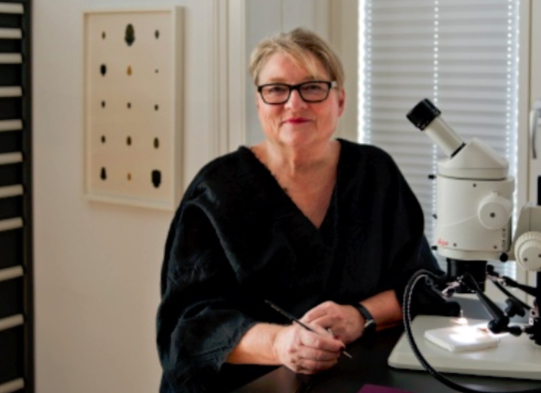
More detail about Cornelia’s work
Vegetation and bugs contaminated by nuclear fallout
Scorpion fly & Soft Bug
Cornelia Hesse-Honegger made her first trip in 1988 to collect true bugs in the environs of the Swiss nuclear power plants Gösgen und Leibstadt, in the Canton of Aargau. She found a big number of highly abnormal insects. As a result of the publication of her work, a huge discussion started on the dangers of low level nuclear radiation.
Of the Scorpion Fly, illustrated on the left above (she found the Soft Bug at around the same time), the artist says:
I found this insect during my first research around Swiss nuclear power plants. The amount of damage and the severances and malformations among insects completely shocked me at the time.
I published Watercolours and a text in a renowned Swiss magazine (das Magazin Nr. 15/ April 1989) For months thereafter the press discussed my suspicion, that the emissions from nuclear power plants were causing those deformations. The scientists claimed that this was not possible. Today we know more about the effect and danger of very low doses of artificial radioactivity.
Cornelia Hesse-Honegger
Green Shield Bug, 1993
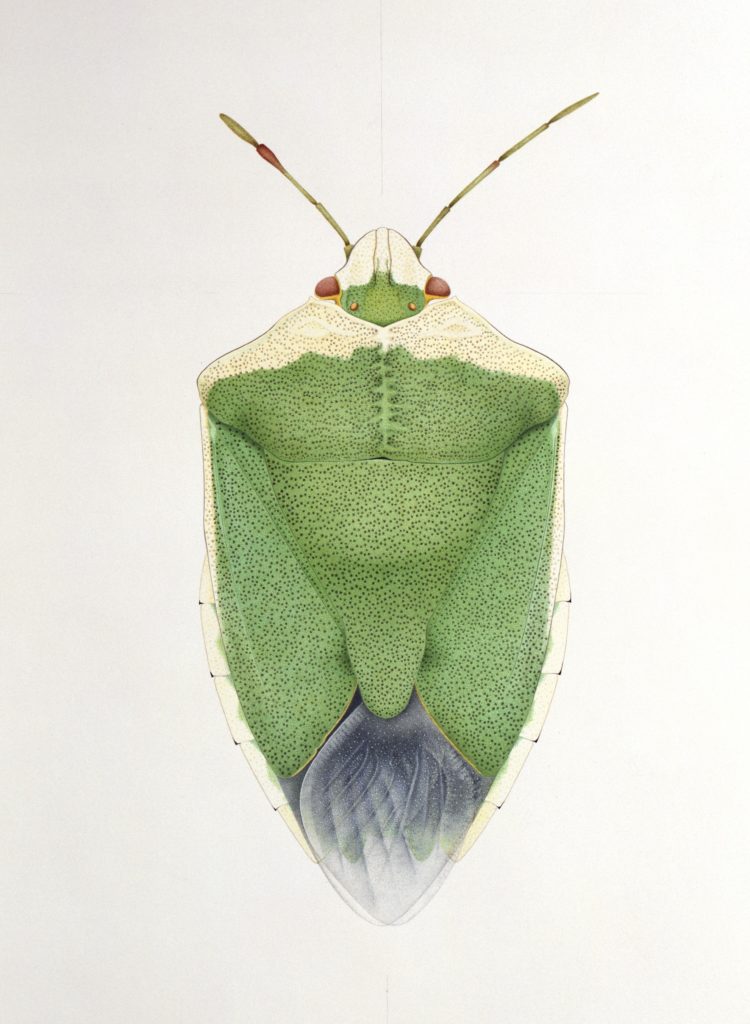
Digital print from original watercolour, 47 x 36 cm
Of this Green Shield Bug, collected in the Var region of southern France in 1993, the artist says:
I collected in this area 12. 04. 1993 as a reference biotope. I painted the insect because it was so beautiful with the different greens. Out of 128 true bugs 8 had morphological deformations and 7 had dark patches on wings, thorax or abdomen. The area was very wild with no agriculture. Scientists ask for reference biotopes with no nuclear power plant nearby. In France, because there are over 50 reactors, it is difficult to find an area that is not irradiated by low-level artificial radiation.My best reference biotope was in the Agent -Orange Spray areas in south Vietnam (2004), where out of 720 collected true bugs 11 had a disturbance.
Cornelia Hesse-Honegger
Harlequin Bug, 1992
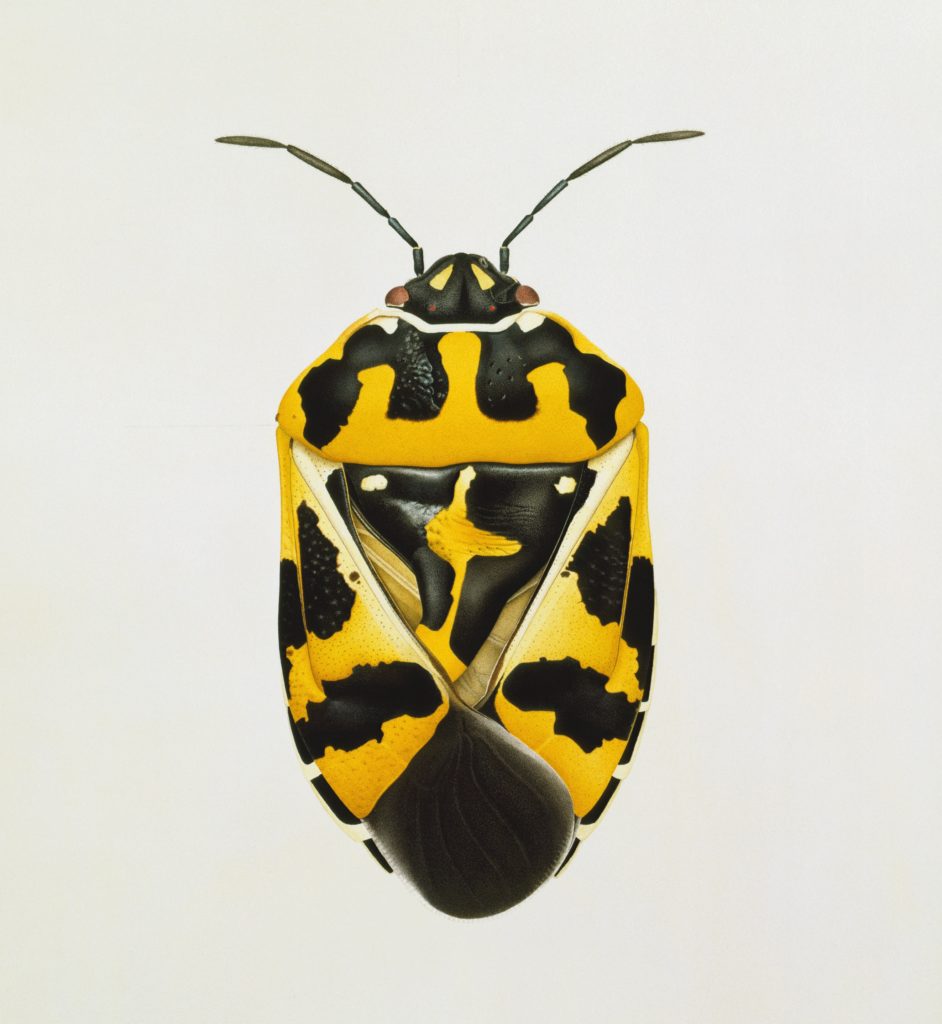
Digital print from original watercolour, 48 x 37 cm
I collected this Harlequin Bug near the nuclear power plant, Three Mile Island, called Governor’s Stable. The left feeler has only four sections, they are disturbed and have new sizes. The shield (at the centre back) is bent and the yellow form is asymmetrical.
The Three Mile Island accident was a partial meltdown of reactor number 2 of Three Mile Island Nuclear Generating Station (TMI-2). It was situated in Dauphin County, Pennsylvania, near Harrisburg. It was the most significant accident in U.S. commercial nuclear power plant history. On the seven-point International Nuclear Event Scale, it was rated a five as an “accident with wider consequences”. There was a subsequent radiation leak on March 28, 1979.
I collected 180 degrees around the nuclear power plant in 1991. Along the Susquehanna River it was difficult because on the northern side was a steel Corporation and an international airport. On the southern side was a US Military Airport and a nature reserve. I collected on 14 sites.
The worst was in the east where I found the Harlequin bug and in Goldsboro just opposite the plant in the west-north-west. As 12 years had passed between the accident and my research, I was not sure what to find. The results were shocking as one of the plants was still working. I cannot say whether the malformations were due to the accident and its cleanup, or the normal working nuclear power plant.
Cornelia Hesse-Honegger
Three Cidadas, 2017
Digital print from original watercolour, 42 x 29.7 cm, Right: Single Cicada, 2017, Cicadella viridis without colour. Digital print from original watercolour, 42 x 29.7 cm
Cornelia describes these as her most shocking discovery. They come from Shinobu Spa near Fukushima City, Japan, The left leaf-hopper has two feelers on the left side and a dark patch on the right wing. The right cicada is too small, with a growth on the thorax. The bug illustrated on the right has lost nearly all its colour.
In 2016 the Fukushima Biennale for artists invited me to give the opening speech for the Citizen Scientist International Symposium on Radiation Protection. For over two weeks beforehand, I collected true bugs and leafhoppers around the 20 km exclusion zone around the nuclear power plant Fukushima Daiichi.
I observed an over 50% rate of disturbances. In areas near the power plant the true bugs were nearly extinct. One survivor was Cicadella viridis, although with heavy deformations and most of them without any natural coloring. Timothy Mousseau described a similar loss of colour on barn swallows in the Chernobyl 30 km exclusion zone.
Four Seed Bugs, 1994.
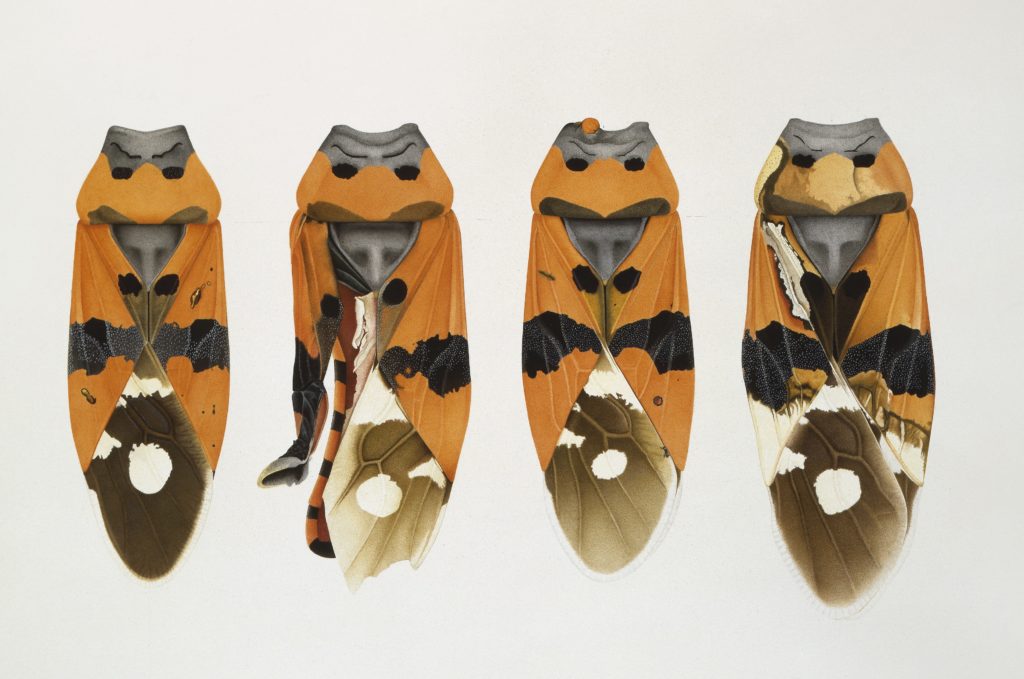
Digital print from original watercolour, 55 x 47 cm
The picture shows different kind of forms of the same disturbance on the same Seed Bug species, from Tubre Italy. They have crumpled wings, blisters, holes, disturbance of pigment and chitin. Tubre was hit by the radioactive cloud from Chernobyl in 1986.
In the year following the accident in the nuclear power plant Chernobyl on April 26 1986, I was researching fallout areas in Sweden, and Ticino, in south Switzerland. Later I collected in other fallout areas in the south east of Switzerland ( Münstertal) and in adjoining areas in Italy (Tubre and Bormio). There was a high rate of deformation.
At that time and even later no biologist was researching because everybody believed that the radiation from Chernobyl was harmless. These areas Münstertal and Vinchgau in Italy are very rural mountain areas with nearly no agriculture.
Cornelia Hesse-Honegger
Further references
See: Cornelia Hesse-Honegger, Heteroptera ‘The Beautiful and The Other’ Scalo Zürich
and
Cornelia Hesse-Honegger, Malformation of True Bugs (Heteroptera): a Phenotype Field Study on the Possible Influence of Artificial Low-Level Radioactivity, Chemistry & Biodiversity 2008
and
Locus+ commissioned and organised the touring exhibition Nach Chernobyl, 1996 and published the related book The Future’s Mirror that same year.
Locus+, Newcastle upon Tyne
Morphological Abnormalities in True Bugs (Heteroptera) near Swiss
Nuclear Power Stations
Alfred Korblein, and Cornelia Hesse-Honegger
www.wissenskunst.ch
Nuclear Free Future Award 2015
Atomic Photographers Guild

